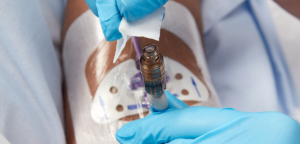Interventional Care


We notice that you are visiting us from . This site only services US-based visitors. Would you like to visit the site that is appropriate for your location?

Despite a 46% reduction in central line-associated bloodstream infections (CLABSIs) in US healthcare facilities from 2008-2013, an estimated 30,000 infections continue to occur annually among hospitalized patients.1 A common mode of pathogenesis for these infections is needleless connector contamination with microorganisms from the patient’s skin and/or the hands of healthcare workers (HCWers). Inadequate disinfection of these connectors, which are accessed multiple times by HCWers in the provision of patient care, can result in intraluminal colonization of the catheter and subsequent bloodstream infection (BSI).
Although needleless connectors (NC) have been used for well over a decade and are recognized portals of entry for microbial contamination, the initial patient safety initiatives for CLABSI reduction focused on central line insertion practices. Process measures associated with catheter maintenance were not addressed. As healthcare facilities began to strive for “zero” CLABSIs, maintenance practices were adopted as additional quality metrics. A need for improvement with NC disinfection was cited by many healthcare facilities. For example, one institution reported that 31% of HCWers failed to disinfect the NC prior to access, even when under direct observation.2 A contributing factor to variability in policies and clinical practice is the lack of an evidence-based guideline which defines the most effective needleless connector antiseptic and the duration of application. The 2011 Centers for Disease Control guidelines for the prevention of intravascular catheter-related infections3 recommend minimizing contamination risk by scrubbing the access port with an appropriate antiseptic (chlorhexidine gluconate, povidone iodine, an iodophor, or 70% alcohol) and accessing the port only with sterile devices.
The use of 70% isopropyl alcohol (IPA) wipes are most commonly used to disinfect needleless connectors using varying duration times, with 15 seconds being a frequently identified and recommended application.4 However, investigators of this catheter maintenance practice found conflicting results. Menyhay and Maki performed a simulation study with needleless connectors heavily contaminated with Enterococcus faecalis and found that a conventional 3-5-second scrubbing with IPA was ineffective in eliminating bacterial transfer.5 In a later paper by Rupp and colleagues6, using S. epidermidis as the inoculum for an in vitro assessment as well as a clinical assessment of NCs, a 5-second IPA scrub was found to be adequate for disinfection.
The discordant findings associated with IPA disinfection alone, the advantage of immediate and sustained bacteriocidal activity of chlorhexidine gluconate/alcohol (CHG/ALC) and the strong evidence supporting the use of CHG/ALC for skin antisepsis prior to the insertion of central catheters, led investigators to evaluate its efficacy for NC disinfection.
In Vitro Studies
Clinical Studies
It is anticipated that further clinical studies evaluating the efficacy of CHG/ALC for NC disinfection to reduce CLABSIs will be forthcoming. However, the current evidence is compelling and it may be time for the CDC Healthcare Infection Control Practices Advisory Committee to elevate the recommendation for its use as was done by the United Kingdom Department of Health when the National Evidence-Based Guidelines for Preventing Healthcare-Associated Infections in NHS Hospitals in England were updated in 2014.
1. CDC National and State Healthcare-Associated Infections Progress Report, published March 2014, available at cdc.gov/HAI/pdfs/progress-report/hai-progress-report.pdf
2 Karchmer T, Cook E, Palavecino E, Ohl C, Sherertz R. Needleless valve ports may be associated with a high rate of catheter-related bloodstream infection. Proceedings of the 15th Annual Scientific Meeting of the Society for Healthcare Epidemiology of America: Los Angeles, CA. April 2005.
3. O’Grady NP, Alexander M, Burns LA, Dellinger EP, et al. Guidelines for the prevention of intravascular catheter-related infections. Am J Infect Control. 2011; 39:S1–S34.
4. Slater K, Cooke M, Whitby M, Fullerton F, et al. Microorganisms present on peripheral intravenous connectors in the clinical environment. Am J Infect Control. 2017;45:932-4.
5. Menyhay SZ, Maki DG. Disinfection of needleless catheter connectors and access ports with alcohol may not prevent microbial entry: the promise of a novel antiseptic-barrier cap. Infect Control Hosp Epidemiol 2006;27:23-27.
6. Rupp ME, Yu S, Huerta T, Cavalieri RJ, et al. Adequate Disinfection of a Split-Septum Needleless Intravascular Connector with a 5-Second Alcohol Scrub. Infect Control Hosp Epidemiol 2012; 33(7):661-665.
7. Kaler W, Chinn R. Successful Disinfection of Needleless Access Ports: A Matter of Time and Friction. JAVA 2007; 12(3):140-142.
8. Hong H, Morrow DF, Sandora TJ, Priebe GP. Disinfection of needleless connectors with chlorhexidine-alcohol provides long-lasting residual disinfectant activity. Am J Infect Control 2013;41:e77-e79.
9. Flynn JM, Rickard CM, Keogh S, Zhang L. Alcohol Caps or Alcohol Swabs With and Without Chlorhexidine: An In Vitro Study of 648 Episodes of Intravenous Device Needleless Connector Decontamination. Infect Control Hosp Epidemiol 2017; 38(5):617-18.
10. Soothill JS, Bravery K, Ho A, Macqueen S, et al. A fall in bloodstream infections followed by a change to 2% chlorhexidine in 70% isopropanol for catheter connection antisepsis: A pediatric single center before/after study on a hemopoietic stem cell transplant ward. Am J Infect Control 2009; 37:626-30.
11. Hayden, M. K., et. al. A Randomized Cross-Over Clinical Trial to Compare 3.15% Chlorhexidine/70% Isopropyl Alcohol (CHG) vs 70% Isopropyl Alcohol Alone (Alcohol) and 5s vs 15s Scrub for Routine Disinfection of Needleless Connectors (NCs) on Central Venous Catheters (CVCs) in an Adult Medical Intensive Care Unit (ICU), Oral Abstract Presented at 2014 ID Week Conference, October 11, 2014, Philadelphia, PA.
12. epic3: National Evidence-Based Guidelines for Preventing Healthcare-Associated Infections in NHS Hospitals in England. Journal of Hospital Infection 86S1 (2014) S1–S70.